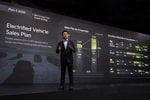More companies are embracing technology to improve efficiencies and reduce risk

Telematics and in-cab cameras are increasingly being used by fleets to improve driver behaviour and bolster safety.
The technologies can record events such as harsh acceleration, braking and cornering, while the data can be used to identify trends and areas which drivers need to be coached in.
Many of the fleet operators who attended a recent Fleet News roundtable, sponsored by Alphabet, already use the systems for these purposes.
The information can also be used to reward the best performing drivers, incentivising them to improve further.
How do you use telematics or in-cab cameras to reduce risk?
Kevin King, fleet services manager, Hermes Parcelnet: We are using telematics and cameras that look at the driver as well as forwards. The company we have gone with looks at every incident the camera picks up and it feeds the ones it deems we should look at back to us so we can then manage those incidents. It takes all the chaff out of it. About a month before our supplier fitted the technology, it got all our drivers in a room and said ‘right, this is what we are doing and this is the reason’. It also showed some of the clips from other companies and this approach meant that when the system went live, we had total buy-in.
Reg Sargeant, resources manager, Hortech: Within a couple of months of fitting telematics, we had a third party call us following a collision with one of our vans and said our driver was doing this and that. When we spoke to our employee he said this wasn’t true. I said it was fine, our telematics recorded this journey and showed that when our driver hit this vehicle he was doing 16mph. We fed that into our insurance company and our driver was deemed not to be at fault. He told all his mates about it and after that everyone bought into telematics, so it was brilliant. As well as vans, every company car driver also has to have a tracker: it comes with the vehicle as part of the lease package. We sold it to our drivers from an HMRC perspective because their private and business mileage is there. It’s indisputable. From the manager’s perspective, they’re fine with it, and we tell everybody the managers have it in their vehicles and why would we treat them differently from anybody else?
Kevin King: The camera is also a coaching tool for us so we can look at the footage and show the driver in real time what he’s done. You can use that to identify training around the incident, such as how far the driver needs to be behind other traffic, or look at the reasons behind events such as sudden braking, which may be a case of judging traffic lights better so there is no need to stop sharply. At the end of the day, we’re all managed and a driver needs to be managed in the cab: without cameras you can’t manage that individual.
Dean Waters, fleet manager, Ideal Boilers: We’ve introduced driver assessments for employees who are new or have an issue. We want to expand that further but I’ve been told that you can’t do assessments on car drivers because it’s patronising, although it’s not patronising to do it for van drivers. We all pass our test when we’re 17 or 18 and then we spend the rest of our lives learning bad habits. I don’t think there’s any problem having a driving assessment every two years just to make sure the driving style is right and people stay safe. I don’t see how trying to help them stay safe is patronising. I hear people say ‘we’re not professional drivers, we’re professional boiler engineers’. We’ve got 120 vehicles doing three million miles a year, and if we’re not professional drivers, then we’ve got a problem.
Do you use the stick or carrot approach to encourage improvements?
Andrew Wearing, fleet manager, Bristow & Sutor: With telematics, the arm around the shoulder approach is the easiest way initially to get people to improve and that should get 80% of drivers onside. Inevitably there may be a small percentage that you need to use the stick on at some point.
Dean Waters: I think there’s a good case for using both. We have four regions – north, central, east and west – and our telematics system can be configured so it allows our regional managers to only see their guys. I am suggesting that each region runs its own reward scheme, but you have to be careful how you do this because all vehicles will offer different results. We are suggesting we have a reward for the biggest improver each month. If you just look at driver behaviour, each driver’s improvement ability will be the same as everyone else’s, so we think that going by biggest improver is the best way.
Kevin King: We’ve got a league table and then take the bottom 10% and retrain those guys. The league table format means people say ‘actually, I don’t want to be at the bottom, I want to be higher’.
Dean Waters: You are always going to have two or three drivers that are determined not to make it work, and they’re the ones that you need to coach.
Mark Garner, fleet manager, Moy Park: It boils down to the company’s culture and the driver’s attitude, because even if you offer £1,000 a month, some drivers are just going to say ‘I haven’t got a chance of winning that, I’m not bothered’, or ‘I’ve not started the week off well, so I’m not going to bother for the rest of the week’, and that’s the problem.
Andrew Wearing: That’s where our driver policy works because if we need to take them to task we can do. I would hope it would never happen, but if it does you need the systems in place to be able to tackle that situation.
Is anyone saving money by having telematics or cameras?
Andrew Wearing: Before we fitted telematics, I was able to get accurate fuel spend data through our fuel cards, and the cost of telematics has already come out of the savings we’ve made on fuel without all the other benefits. Our fuel consumption immediately dropped by 10%. We were driving fuel spend savings quite hard before telematics, but we’d reached a line we couldn’t get beyond. We had some drivers in small vehicles doing 60+mpg and others in the same vehicles doing less than 40mpg, so clearly we knew we had drivers who could do better. However, I don’t think the biggest saving will be on fuel, it’s going to be wear and tear. I know we are going to get major savings on brake pads and discs, tyres and general mechanical wear on the vehicle: telematics will get our fleet to a much higher mileage with less wear and tear. We also use telematics as a management tool. I knew who the good and bad drivers were before we fitted telematics three or four months ago, but the technology identifies what the problems are with the drivers in terms of acceleration, braking and changing direction. This allows you to target those drivers directly and the fact our telematics system has a light display on the dash will allow them to self-monitor.

















alastair protheroe - 23/12/2016 11:54
The point of the Carrot is to incentivise and help the driver. [---advertising content removed---]